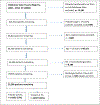Survival Benefit of Treatment at or Transfer to a Tertiary Trauma Center among Injured Older Adults
- PMID: 31211622
- PMCID: PMC6962564
- DOI: 10.1080/10903127.2019.1632997
Survival Benefit of Treatment at or Transfer to a Tertiary Trauma Center among Injured Older Adults
Abstract
Objective: It is well established that seriously injured older adults are under-triaged to tertiary trauma centers. However, the survival benefit of tertiary trauma centers (TC) compared to a non-tertiary trauma centers (Non-TCs) remains unclear for this patient population. Using improved methodology and a larger sample, we hypothesized that there was a difference in hospital mortality between injured older adults treated at TCs and those treated at Non-TCs. Methods: This was a retrospective cohort study of injured older adults (> =55 years) reported to the Oklahoma statewide trauma registry between 2005 and 2014. The outcome of interest was 30-day in-hospital mortality and the exposure variable of interest was level of definitive trauma care (TC vs Non-TC). Overall survival benefit of treatment at a TC as well as the survival benefit of transferring injured older adults to a TC were evaluated using multivariable survival analyses as well as propensity score-adjusted analyses. Results: Of the 25,288 patients eligible for analysis, 43% (10,927) were treated at TCs. Multivariable Cox regression analyses revealed effect modification by age group and time. After adjusting for potential confounders within the age strata, overall, patients treated at TCs were significantly less likely to die within 7 days of admission and this effect was stronger for patients aged 55-64 years (HR 0.41, 95% CI 0.31-0.52) compared to those > =65 years (HR 0.62, 95% CI 0.55-0.70). Overall survival benefit of TCs beyond 7 days was also observed (HR 0.68, 95% CI 0.56-0.83). Similarly, for the survival benefit of transferring injured older adults, after adjusting for the propensity to be transferred and other confounders, transfer to a TC was associated with lower 30-day mortality both for patients less than 65 years old (HR 0.36, 95% CI: 0.27-0.49) and those 65 years and older (HR 0.55, 95% CI: 0.48-0.64). Conclusions: Our results suggest a survival benefit for injured older adults treated at TCs. This benefit was also observed for patients transferred from non-tertiary trauma centers. Further research should focus on identifying specific subgroups of patients who would especially benefit from this level of care to minimize trauma triage inefficiencies.
Keywords: injured older adults; survival benefit; tertiary trauma centers.
Conflict of interest statement
The authors declare no conflict of interest.
Figures



References
-
- Schwab CW, Kauder DR. Trauma in the geriatric patient. Arch Surg. 1992;127(6):701–706. - PubMed
-
- Lane P, Sorondo B, Kelly JJ. Geriatric trauma patients-are they receiving trauma center care? Acad Emerg Med. 2003;10(3):244–250. - PubMed
-
- Knudson MM, Lieberman J, Morris JA Jr., Cushing BM, Stubbs HA. Mortality factors in geriatric blunt trauma patients. Arch Surg. 1994;129(4):448–453. - PubMed
-
- Victorino GP, Chong TJ, Pal JD. Trauma in the elderly patient. Arch Surg. 2003;138(10):1093–1098. - PubMed
Publication types
MeSH terms
Grants and funding
LinkOut - more resources
Full Text Sources
Medical
